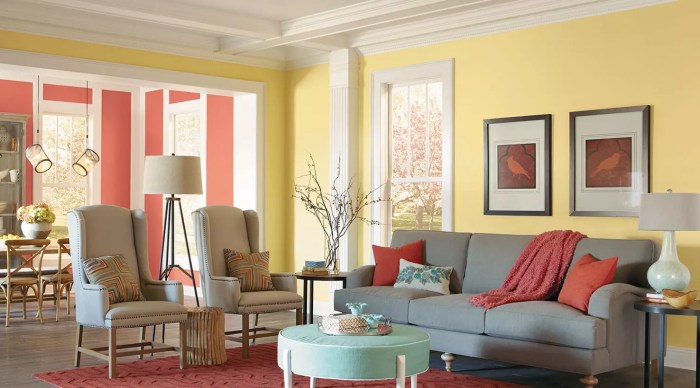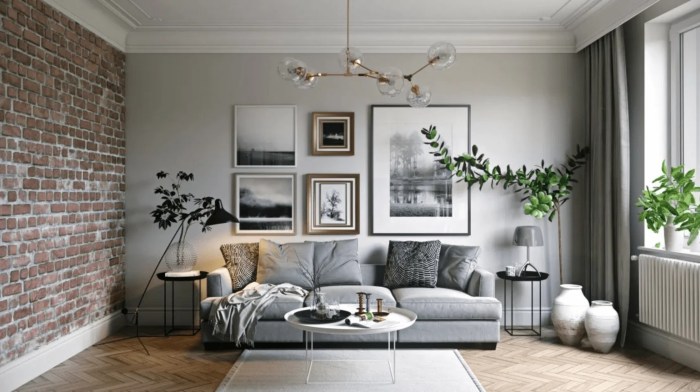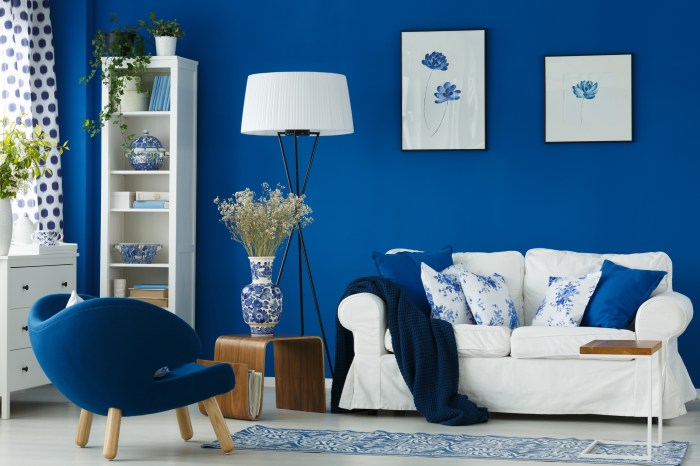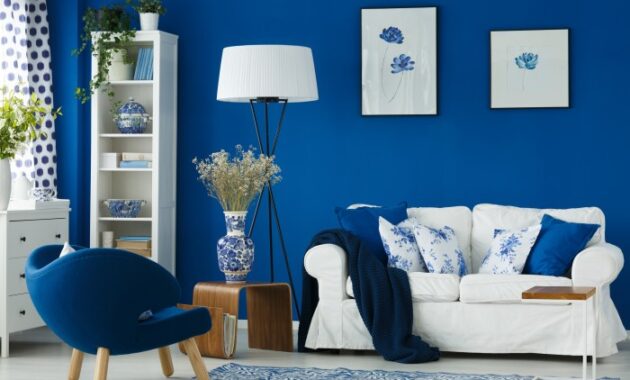Color interior house design sets the stage for this enthralling narrative, offering readers a glimpse into a story that is rich in detail and brimming with originality from the outset.
The art of color interior house design goes beyond simply choosing pretty hues. It’s about understanding the psychology of color, the latest trends, and the subtle ways in which color can transform a space. This guide delves into the fascinating world of color and its power to create mood, evoke emotions, and enhance the overall aesthetic of your home.
Color and Furniture: Color Interior House Design

Color plays a crucial role in how furniture is perceived and integrated into a room’s overall design. It can be used to accentuate, downplay, or even create a focal point around a particular piece.
Using Color to Highlight or Downplay Furniture
Color can effectively highlight or downplay furniture pieces. A vibrant sofa in a neutral room will naturally stand out, while a lighter-toned chair in a richly colored space might blend in. Here are some examples:
- A bright red armchair against a backdrop of white walls will draw the eye and become a focal point.
- A dark brown leather sofa in a room with deep blue walls will create a cohesive and sophisticated look, blending seamlessly.
- A light gray couch in a room with bold patterned wallpaper will appear less prominent and allow the wallpaper to be the main visual element.
Using Color to Create Visual Interest and Define Areas
Color can also be used to create visual interest and define different areas within a room. For example, you can use a contrasting color on a wall behind a bookshelf to make it appear more prominent. Or, you can use a different color on the floor in a dining area to separate it from the rest of the living space.
- Painting a wall behind a fireplace a bolder color can create a focal point and draw attention to that area.
- Using a contrasting rug in a dining area can visually separate it from the living room, creating a distinct space.
- A lighter color on the ceiling can make a room feel taller and more spacious.
Choosing Furniture Upholstery and Fabrics
When choosing furniture upholstery and fabrics, it’s important to consider the overall color scheme of the room. Here are some tips:
- Neutral Base:Start with a neutral base for your furniture, such as beige, gray, or cream. This will provide a foundation for adding pops of color through accent pieces, pillows, or throws.
- Complementary Colors:Choose upholstery and fabrics that complement the main colors in your room. For example, if your walls are a soft blue, consider using a warm brown or orange for your furniture.
- Consider the Texture:Texture can add depth and visual interest to a room. For example, you could use a velvet sofa with a textured throw blanket.
- Think About Durability:If you have children or pets, consider choosing fabrics that are stain-resistant and easy to clean.
Color and Accessories

Accessories are the finishing touches that bring a room to life, adding pops of color, texture, and personality. They allow you to express your style and create a unique atmosphere that reflects your taste.
Choosing the right colors for your home interior can be a daunting task, but it’s an important one. It sets the mood and reflects your personality. While the overall architecture of your home is a crucial factor, architecture house interior design plays a key role in how you use color.
You can create a cohesive and stylish space by considering the architectural elements and choosing colors that complement them. This will ensure your home is both beautiful and functional.
Using Color in Accessories, Color interior house design
Accessories play a crucial role in enhancing color schemes, adding depth and visual interest. They provide opportunities to introduce accents, patterns, and textures that complement the overall color palette. Here’s a table illustrating how various types of accessories can be used to enhance color schemes:
| Accessory Type | Color Usage | Example |
|---|---|---|
| Throw Pillows | Introduce bold accent colors, patterns, or textures that complement the main color scheme. | A neutral sofa with a vibrant throw pillow in a complementary color, such as a navy sofa with a coral throw pillow. |
| Rugs | Define areas, add warmth, and introduce a dominant color or pattern. | A beige living room with a navy blue rug to define the seating area and add a pop of color. |
| Artwork | Create focal points, add visual interest, and introduce a specific color or theme. | A white bedroom with a vibrant abstract painting in a contrasting color, such as a bright yellow or red. |
| Vases and Flowers | Bring in fresh color and life to a space. | A minimalist living room with a colorful vase filled with vibrant flowers in a complementary color. |
| Lamps | Add a warm glow and introduce a decorative element. | A neutral bedroom with a lampshade in a soft, calming color like lavender. |
| Mirrors | Reflect light, create the illusion of space, and introduce a decorative element. | A small entryway with a mirror with a decorative frame in a metallic color. |
| Candles | Add warmth and ambiance, and introduce a decorative element. | A dining room with candles in a set of matching colors to create a romantic atmosphere. |
“Accessories are the jewelry of a room, adding sparkle and personality.”
Color and Sustainability
In the realm of interior design, sustainability is gaining increasing importance as we strive to create spaces that are both aesthetically pleasing and environmentally responsible. Color plays a crucial role in achieving this harmony, as it can influence our mood, well-being, and connection to the natural world.
Sustainable Paint and Color Products
The use of sustainable and eco-friendly paint and color products is a fundamental aspect of creating a sustainable interior design. These products are formulated with low volatile organic compounds (VOCs), which are harmful chemicals that can contribute to indoor air pollution and health problems.
- Low-VOC paints: These paints release minimal amounts of VOCs, reducing their impact on indoor air quality and the environment. They are typically made with natural ingredients like plant-based resins and pigments.
- Water-based paints: Water-based paints are a popular alternative to solvent-based paints as they emit fewer VOCs and are generally safer for indoor use.
- Recycled content paints: Some paint manufacturers use recycled materials in their formulations, reducing waste and promoting a circular economy.
Biophilic Design and Natural Colors
Biophilic design is a concept that emphasizes the connection between humans and nature. It incorporates natural elements, materials, and colors to create spaces that promote well-being, reduce stress, and enhance productivity.
Color is a powerful tool in interior design, setting the mood and influencing the overall feel of a space. When working with a smaller footprint, like a 25 sqm house, it’s crucial to utilize color strategically. You can find inspiration and practical tips for maximizing space in a 25 sqm house interior design guide, which often includes color palettes for maximizing space and creating a sense of openness.
By carefully choosing colors, you can transform a small house into a stylish and inviting home.
- Natural Colors: Biophilic design often incorporates natural colors inspired by the environment, such as earthy tones, greens, blues, and browns. These colors evoke a sense of calm and tranquility, creating a soothing atmosphere.
- Natural Materials: The use of natural materials like wood, stone, bamboo, and cork is central to biophilic design. These materials not only contribute to a sustainable interior but also provide a tactile connection to nature.
Sustainable Color Choices
Sustainable color choices can promote well-being and environmental responsibility.
Choosing the right color palette for your home can be a daunting task. Fortunately, there are plenty of resources available to help you visualize your dream interior. You can explore various color combinations and see how they would look in your space using an app to design house interior.
These apps offer a user-friendly interface and a wide range of color options, allowing you to experiment with different shades and styles until you find the perfect look for your home.
- Light and Reflective Colors: Light colors like white, cream, and pastels can reflect natural light, reducing the need for artificial lighting and lowering energy consumption.
- Earthy Tones: Earthy tones like brown, green, and beige are inspired by nature and create a sense of grounding and stability. They are often associated with calmness and relaxation, promoting a sense of well-being.
- Cool Colors: Cool colors like blue and green can have a calming effect on the mind and body, creating a serene and relaxing atmosphere.
Color and Technology

Technology has revolutionized the way we approach interior design, offering a wealth of tools and solutions to help homeowners make informed decisions about color choices. From color-matching apps to smart lighting systems, technology plays a crucial role in enhancing the impact of color in our homes.
Color-Matching Apps and Online Tools
Color-matching apps and online tools have made it easier than ever for homeowners to choose and visualize color schemes. These platforms offer a variety of features, such as:
- Color palettes:Pre-defined color palettes based on various design styles, moods, and themes.
- Virtual paint tools:Allow users to virtually paint their walls with different colors and see how they look in their own space.
- Color matching:Enable users to upload a photo of an object or room and match colors from it.
Examples of popular color-matching apps include Sherwin-Williams ColorSnap, Benjamin Moore Color Portfolio, and PPG Paints Virtual Painter. These apps allow users to explore a wide range of colors, create custom palettes, and visualize how different colors would look in their homes.
Smart Lighting and Color Control
Smart lighting systems offer advanced control over the color and intensity of light in interior spaces. By integrating with home automation systems, smart lighting can be controlled remotely, scheduled, and adjusted based on user preferences or environmental conditions.
- Color temperature:Smart lighting systems can adjust the color temperature of light, from warm white to cool white, to create different moods and ambiance.
- Color customization:Some smart lighting systems allow users to choose from a wide range of colors to create specific lighting effects.
- Scene settings:Pre-programmed lighting scenes can be created for different activities, such as reading, dining, or entertaining.
For example, Philips Hue smart bulbs offer a wide range of colors and can be controlled via a smartphone app. This allows homeowners to adjust the color of their lighting to match their mood or the time of day.
Technology Enhancing Color Impact
Technology can enhance the impact of color in home design in several ways:
- Color accents:Smart lighting can be used to highlight specific color accents in a room, such as artwork or furniture.
- Color transitions:Smart lighting systems can create gradual color transitions throughout the day, simulating natural sunlight.
- Color mood:Different colors can evoke different emotions, and smart lighting can be used to create specific moods, such as calming, energizing, or romantic.
For instance, a homeowner might use smart lighting to create a warm, inviting ambiance in their living room by setting the lights to a soft, amber hue. In contrast, they might use cool, blue lighting in their home office to promote focus and productivity.
Outcome Summary
From the impact of color psychology to the latest trends and the interplay of color and materials, this guide provides a comprehensive understanding of how to use color to create a beautiful and functional living space. By incorporating the principles Artikeld here, you can transform your home into a sanctuary that reflects your unique personality and style.
Key Questions Answered
How do I choose the right color for my living room?
Consider the size of the room, the amount of natural light, and the desired ambiance. For a small living room, light colors can make the space feel larger. For a room with limited natural light, warm colors can create a cozy atmosphere.
What are some popular color trends for 2023?
Some popular color trends for 2023 include earthy tones like terracotta and sage green, as well as bolder colors like deep blues and rich purples.
What are some tips for incorporating color into my home office?
Choose colors that promote focus and productivity, such as blues, greens, and grays. Avoid using too many bright or distracting colors.
What are some sustainable paint options?
Look for paints that are low-VOC (volatile organic compounds), water-based, and made with recycled materials. Some brands also offer plant-based paint options.

